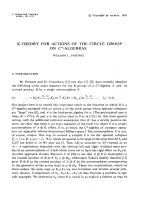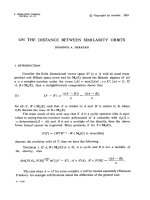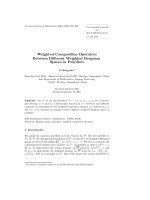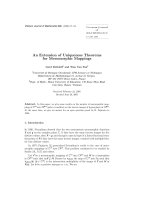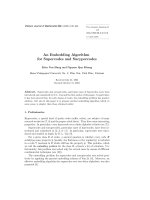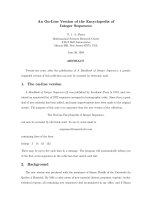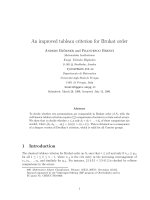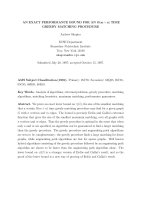Báo cáo toán học: "An Area-to-Inv Bijection Between Dyck Paths and 312-avoiding" ppsx
Bạn đang xem bản rút gọn của tài liệu. Xem và tải ngay bản đầy đủ của tài liệu tại đây (243.71 KB, 16 trang )
An Area-to-Inv Bijection Between Dyck Paths
and 312-avoiding Permutations
Jason Bandlow and Kendra Killpatrick
Mathematics Department
Colorado State University
Fort Collins, Colorado
Submitted: July 23, 2001; Accepted: December 10, 2001.
MR Subject Classifications: 05A15, 05A19
Abstract
The symmetric q, t-Catalan polynomial C
n
(q, t), which specializes to the Catalan
polynomial C
n
(q)whent = 1, was defined by Garsia and Haiman in 1994. In 2000,
Garsia and Haglund described statistics a(π)andb(π) on Dyck paths such that
C
n
(q, t)=
π
q
a(π)
t
b(π)
where the sum is over all n × n Dyck paths. Specializing
t = 1 gives the Catalan polynomial C
n
(q) defined by Carlitz and Riordan and
further studied by Carlitz. Specializing both t =1andq = 1 gives the usual
Catalan number C
n
. The Catalan number C
n
is known to count the number of
n × n Dyck paths and the number of 312-avoiding permutations in S
n
,aswellasat
least 64 other combinatorial objects. In this paper, we define a bijection between
Dyck paths and 312-avoiding permutations which takes the area statistic a(π)on
Dyck paths to the inversion statistic on 312-avoiding permutations. The inversion
statistic can be thought of as the number of (21) patterns in a permutation σ.We
give a characterization for the number of (321), (4321), ,(k ···21) patterns that
occur in σ in terms of the corresponding Dyck path.
1 Introduction
The polynomial C
n
(q, t), called the q, t-Catalan polynomial, was introduced in 1994 by
Garsia and Haiman [5]. They conjectured that it is the Hilbert series of the diagonal
harmonic alternates and showed that it is the coefficient of the elementary symmetric
function e
n
in the symmetric polynomial DH
n
(x; q, t); the conjectured Frobenius charac-
teristic of the module of diagonal harmonic polynomials. The polynomial is referred to
as the q, t-Catalan polynomial because specializing t =1givestheq-Catalan polynomial
the electronic journal of combinatorics 8 (2001), #R40 1
first given by Carlitz and Riordan [3] and further studied by Carlitz [2]. Specializing both
q = t = 1 results in the well-known Catalan number C
n
=
1
n+1
2n
n
.
In order to give the precise definition of C
n
(q, t), we must first introduce some notation.
A sequence µ =(µ
1
,µ
2
, ,µ
k
) is said to be a partition of n if µ
1
≥ µ
2
≥···≥µ
k
> 0and
µ
1
+ µ
2
+ ···+ µ
k
= n. A partition µ may be described pictorially by it’s Ferrers diagram,
an array of n dots into k left-justified rows with row i containing µ
i
dots for 1 ≤ i ≤ k.
Using the Ferrers diagram we can define the transpose of a partition µ, denoted µ
T
,to
be the partition whose ith row (numbered from the top) is the length of the ith column
in the Ferrers diagram of µ. The symbols l and l
are used to represent the leg and coleg
of a cell: the number of cells strictly below and strictly above a given cell, respectively.
Similarly, a and a
represent the arm and coarm of a cell: the number of cells strictly to
the right and strictly to the left of a given cell, respectively. For example, for the labelled
cell s in the diagram below, a =5,a
=4,l =3,andl
=2.
The precise definition of C
n
(q, t) is given as follows:
C
n
(q, t)=
µn
t
2Σl
q
2Σa
(1 − t)(1 − q)
(0,0)
(1 − q
a
t
l
)
q
a
t
l
(q
a
− t
l+1
)(t
l
− q
a+1
)
The summations and products within the µ
th
summand are over all cells in the Ferrers
diagram of a given partition, and the symbol Π
(0,0)
is used to represent the product over
all cells but the upper left corner.
The q, t-Catalan polynomial is symmetric in q and t; i.e, C
n
(q, t)=C
n
(t, q). To see
this, note that for every µ n, µ
T
is also a partition of n. We can see that the summand
corresponding to µ in C
n
(q, t) will equal the summand corresponding to µ
T
in C
n
(t, q)
by observing the relationships between a, l, a
,andl
in µ and µ
T
. Given a cell s in a
partition µ, the arm length of s in µ equals the leg length of the corresponding cell s
in µ
T
, and vice-versa. Similarly, the lengths of the coarm and coleg of s and s
are also
interchanged. This can be seen in the diagram below, which shows the transpose of the
first diagram, and the corresponding cell, s
. Note that here, l =5,l
=4,a =3,and
a
=2.
the electronic journal of combinatorics 8 (2001), #R40 2
Though symmetry follows directly from the definition of the q, t-Catalan polynomial,
it is less obvious that this polynomial has positive integer coefficients. To prove this,
Garsia and Haiman conjectured that there exist statistics a(π)andb(π)onn × n Dyck
paths, D
n
, such that C
n
(q, t)=
π∈D
n
q
a(π)
t
b(π)
. (A complete description of Dyck paths
follows in Section 2.) For a given path π,thestatistica(π) is the number of full squares
which lie below the path and completely above the line y = x [4]. To compute b(π),
we first construct a second Dyck path from π called β(π); then b(π) is the sum of the
x-coordinates of the points where this second path touches the line y = x, excluding the
points (0, 0) and (n, n). (See Section 3 for a more complete description of b(π).) The b(π)
statistic was first conjectured by Haglund [7] and then proved to be correct by Garsia and
Haglund [5].
Since C
n
(q, t)=C
n
(t, q), there must exist a bijection from D
n
to D
n
that maps π
to π
, such that a(π)=b(π
)andb(π)=a(π
). It is an open problem to define such a
bijection constructively. A possible approach to find such a bijection is to make use of
some of the 66 other known descriptions of the Catalan numbers [11]. More work has
been done on the development of statistics for some of these objects than others.
In particular, many statistics have been developed for permutations. While investigat-
ing permutations that could be sorted on a single pass through a stack, Knuth [8] showed
that (312)-avoiding permutations satisfy the Catalan recurrence. The inv statistic, or in-
version statistic, is defined as the number of “inversions” in a permutation, or alternately
as n(21): the number of patterns of the form (21) in a permutation. F¨urlinger and Hof-
bauer [4] proved that the q-Catalan polynomial is the generating function for inversions
on (312)-avoiding permutations.
The main result of this paper is to give a bijection from Dyck paths to (312)-avoiding
permutations that sends the area statistic on Dyck paths to the inv statistic on (312)-
avoiding permutations. In addition, we will classify the occurrence of permutation pat-
terns n(321), n(4321), , n(k ···21) in terms of Dyck paths.
Since the a(π)andb(π) statistics are equidistributed on Dyck paths, the hope is to find
another statistic on permutations which, when restricted to (312)-avoiding permutations,
gives the corresponding b(π) statistic under our bijection. An examination of the statistics
known to be equidistributed with inv, however, has not yet yielded any such result.
the electronic journal of combinatorics 8 (2001), #R40 3
In section 2, we give the necessary definitions and background for this paper. Section
3 contains the construction of our bijection and the proof that it sends the area statistic
on Dyck paths to the inv statistic on (312)-avoiding permutations. Section 4 gives our
characterization of n(321), n(4321), , n(k ···21), and Section 5 discusses some open
questions.
2 Background and Definitions
The Catalan sequence is the sequence
{C
n
}
∞
n=0
= {1, 1, 2, 5, 14, 42, }
where
C
n
=
1
n +1
2n
n
.
C
n
is called the nth Catalan number. The Catalan numbers have been shown to count
certain properties on more than 66 different combinatorial objects (see Stanley [11] pg.
219, Exercise 6.19 for a complete list). The objects of use to us in this paper will be
certain lattice paths called Dyck paths and certain permutations called 312-avoiding per-
mutations.
A Dyck path is a lattice path in Z
2
from (0, 0) to (n, n) consisting of only steps in the
positive x direction (EAST steps) and steps in the positive y direction (NORTH steps)
such that there are no points (x, y) on the path for which x>y. In other words, a Dyck
path is a path from (0, 0) to (n, n) consisting only of NORTH and EAST steps that never
goes below the diagonal. Let D
n
denote the set of Dyck paths from (0, 0) to (n, n). For
example, D
3
consists of the following paths:
The Catalan number C
n
is known to count the number of Dyck paths from (0, 0) to
(n, n), thus C
3
=5. Thelength of a Dyck path is the number of NORTH steps in the
path, thus a Dyck path π ∈ D
n
has length n.
Let S
n
denote the symmetric group on [n]={1, 2, ,n}.Atransposition s
i
=(i, i+1)
is a function from S
n
to S
n
which interchanges the numbers in the ith and (i+1)st position
in a permutation. For example,
s
4
(512867394) = 512687394.
It is well-known that every permutation σ in S
n
can be represented as a sequence of trans-
positions s
i
1
s
i
2
s
i
k
which, when applied from right to left to the identity permutation
123 ···n,resultsinσ. This representation is not necessarily unique. For example, 321
can be written as both s
1
s
2
s
1
and s
2
s
1
s
2
. We will describe one method for writing a
permutation as such a product of transpositions in the following section.
the electronic journal of combinatorics 8 (2001), #R40 4
A 312-avoiding permutation π ∈ S
n
is a permutation π = π
1
π
2
···π
n
containing no
triple π
i
π
j
π
k
with i<j<ksuch that π
i
>π
k
>π
j
. For example, π = 2143 is a
(312)-avoiding permutation in S
4
while σ = 4213 is not.
Let S
n
(312) denote the set of all 312-avoiding permutations in S
n
and let A
n
(312) =
|S
n
(312)|. In [8], Knuth proved that, for every R ∈ S
3
,
A
n
(R)=
1
n +1
2n
n
= C
n
.
In particular, if R = (312), this proves that C
n
equals the number of 312-avoiding per-
mutations.
In addition to having an explicit formula, the Catalan numbers are known to satisfy
the recurrence
C
n
=
n
i=1
C
i−1
C
n−i
.
This can easily be visualized using the Dyck paths. Given a Dyck path from (0, 0) to
(n, n), label the diagonal points in Z
2
as a
i
=(i, i) for 1 ≤ i ≤ n.Let
A
i
= {Dyck paths from (0, 0) to (n, n) that first touch the diagonal at a
i
}.
In other words, A
i
is the set of paths for which i is the smallest integer such that (i, i)isa
point on the path. Then clearly C
n
=
n
i=1
|A
i
|. It remains to show that |A
i
| = C
i−1
C
n−i
.
If a path first touches the diagonal at (i, i), the path must go from (0, 1) to (i − 1,i)
without touching the diagonal points (1, 1), (2, 2), ,(i − 1,i− 1). The number of
such paths is C
i−1
. Once the path touches (i, i)itmustthencontinueto(n, n) without
going below or to the right of the diagonal. The number of such paths is C
n−i
.Thus
|A
i
| = C
i−1
C
n−i
and therefore
C
n
=
n
i=1
|A
i
| =
n
i=1
C
i−1
C
n−i
.
For example, if n =10andi = 3, then any path in A
3
must go from (0, 0) to (0, 1), then
take some path from (0, 1) to (2, 3) without touching (1, 1) or (2, 2). Since the chosen
path is in A
3
, it must then go from (2, 3) to (3, 3) and then it can take any valid Dyck
path from (3, 3) to (10, 10). One example of such a path is:
the electronic journal of combinatorics 8 (2001), #R40 5
A statistic on a permutation, Dyck path, or other combinatorial object counts some
property about that object. The inversion statistic on a permutation σ ∈ S
n
is defined
by
inv(σ)=
1≤i<j≤n
σ
i
>σ
j
1.
For example, if σ = 743216598, then inv(σ) = 14 since each of the pairs (21), (31),
(41), (71), (32), (42), (72), (43), (73), (74), (65), (75), (76), and (98) contributes 1 to the
sum.
The generating function for the inversion statistic on S
n
is given by
σ∈S
n
q
inv(σ)
.
Two different statistics on a class of objects are said to be equidistributed if they have
the same generating function on that class of objects. A statistic on permutations is called
Mahonian if it is equidistributed with the inv statistic on permutations in S
n
. One well-
known Mahonian statistic is the major index, written maj(σ), first given by MacMahon
[10]. The major index is defined in terms of descents in a permutation. A descent in a
permutation σ = σ
1
σ
2
σ
n
is a position where σ
i
>σ
i+1
. For example, σ = 7136254 has
3 descents. The major index is defined as the sum of the positions of the descents of σ,
i.e.
maj(σ)=
σ
i
>σ
i+1
i.
For the previous permutation σ, maj(σ)=1+4+6=11.
In addition to defining statistics on permutations, we can define statistics on Dyck
paths. Given a Dyck path π ∈ D
n
the area statistic, a(π), is the number of squares that
lie below the path and completely above the diagonal. For example, given the following
Dyck path the squares counted by the area statistic are shaded, giving an area statistic
of 13.
the electronic journal of combinatorics 8 (2001), #R40 6
The generating function for the area statistic on Dyck paths π ∈ D
n
,
π∈D
n
q
a(π)
= C
n
(q),
is the q-Catalan polynomial [4]. Specializing q =1intheq-Catalan polynomial gives the
usual Catalan number C
n
.F¨urlinger and Hofbauer [4] showed that
C
n
(q)=
n
i=1
q
i−1
C
i−1
(q)C
n−i
(q).
To visualize this recurrence, use notation similar to our explanation of the recurrence
for the Catalan numbers. Let
A
i
(q)=
π∈A
i
q
a(π)
.
Clearly,
C
n
(q)=
n
i=1
A
i
(q).
Then to understand the q-Catalan recurrence, it is necessary to understand why
A
i
(q)=q
i−1
C
i−1
(q)C
n−i
(q).
Since a path in A
i
first touches the diagonal at (i, i), it must go from (0, 1) to (i − 1,i)
without touching the diagonal points (1, 1), (2, 2), ,(i−1,i−1). These number of such
paths has been shown to be C
i−1
and thus have weight C
i−1
(q). To these paths, we must
add the i − 1 squares just above the diagonal from (0, 0) to (i, i). Thus the part of the
paths from (0, 0) to (i, i)inA
i
give us a weight of q
i−1
C
i−1
(q). From (i, i), the paths must
then continue on to (n, n) without going below the diagonal. These paths have weight
C
n−i
(q), giving us a total weight of
A
i
(q)=q
i−1
C
i−1
(q)C
n−i
(q).
Using the same example of a path in A
3
as previously, the additional 2 squares giving
the weight q
2
are shaded in black:
the electronic journal of combinatorics 8 (2001), #R40 7
Returning to the q,t-Catalan polynomial of Garsia and Haiman [6], these authors
showed that C
n
(q, 1) = C
n
(q). In addition, they conjectured the existence of a statistic
b(π)onDyckpathsπ ∈ D
n
such that
C
n
(q, t)=
π∈D
n
q
a(π)
t
b(π)
.
Haglund [7] conjectured that b(π) was given by a statistic he called maj(β(π)). This
conjecture was recently proved by Garsia and Haglund [5].
To determine the statistic maj(β(π)) for π ∈ D
n
, one first obtains the path β(π)
which can be thought of as a “billiard ball” path. To obtain this path from π ∈ D
n
,first
imagine shooting a ball straight WEST from (n, n) and just below the path until reaching
a vertical step in π. Reflect the path of the ball directly SOUTH from this point until
reaching the diagonal. At the diagonal, reflect the path directly WEST and still slightly
under the path π until reaching another vertical step in π, upon which the path is again
reflected SOUTH until reaching the diagonal. Continue in this manner until reaching the
point (0, 0).
Label the diagonal points by (i, i)=n − i for 1 ≤ i ≤ n − 1. Then b(π)=maj(β(π))
is the sum of the labels where the path β(π) touches the diagonal (not including (n, n)or
(0, 0)). For example, the bold line denotes the path π ∈ D
n
and the dashed line denotes
the path β(π) in the diagram below.
the electronic journal of combinatorics 8 (2001), #R40 8
For this path π, b(π)=maj(β(π))=2+6+7+9=24.
By the symmetry of C
n
(q, t), as explained in the Introduction section,
C
n
(q, t)=C
n
(t, q)
so
C
n
(q)=C
n
(q, 1) = C
n
(1,q)=C
n
(1,t)=C
n
(t, 1) = C
n
(t).
Thus
π∈D
n
q
a(π)
=
π∈D
n
t
b(π)
.
While a bijection between Dyck paths is known [9] that sends a Dyck path π
1
to a
Dyck path π
2
such that b(π
1
)=a(π
2
), this bijection does not have the property that
a(π
1
)=b(π
2
). Finding such a bijection is an interesting open problem and would give a
combinatorial proof of the symmetry of the q, t-Catalan polynomial.
3 Bijection Between Dyck Paths and
312-avoiding Permutations
Before stating and proving our main theorem, we will describe a well-defined method for
writing a permutation σ ∈ S
n
(312) as a product of adjacent transpositions s
i
.
Let σ ∈ S
n
(312). Write σ as a product of adjacent transpositions s
i
by first determining
a specific sequence of adjacent transpositions which, when applied to σ, will give the
identity permutation. Then σ can be represented by the inverse of this sequence of
transpositions.
To determine the specific sequence of adjacent transpositions, suppose n is in position
i in σ.Thens
n−1
s
n−2
···s
i+1
s
i
(applied right to left) moves the n to position n and
leaves the relative order of the numbers 1 through n − 1 unchanged. Now locate n −
1 in the resulting permutation. Suppose n − 1 is in position j. Then the sequence
s
n−2
s
n−3
···s
j+1
s
j
moves the n − 1topositionn − 1. Continuing in this manner will give
the identity permutation. Then σ can be represented as the inverse of this sequence of
transpositions. Since s
2
i
= id then s
−1
i
= s
i
so the inverse of this sequence of transpositions
is the same sequence written in reverse order. Thus σ is represented by a product of
the electronic journal of combinatorics 8 (2001), #R40 9
adjacent transpositions s
i
whose subscripts form a series of increasing subsequences, i.e.,
σ = σ
1
σ
2
···σ
j
with j ≤ n such that each σ
i
is a product of adjacent transpositions whose
subscripts are strictly increasing. In this representation, j is the minimum number of such
subsequences.
For example, let
σ =23168795104.
Then s
9
moves the 10 to the last position, giving
s
9
(σ)=23168795410.
Next s
8
s
7
moves the 9 to the 9th position, s
7
s
6
s
5
moves the 8 to the 8th position, s
6
s
5
moves the 7 to the 7th position, s
5
s
4
moves the 6 to the 6th position, s
4
moves the 5 to
the 5th position, the 4 is already in the 4th position, s
2
moves the 3 to the 3rd position,
and s
1
moves the 2 to the 2nd position. Then σ can be represented as the inverse of this
sequence of transpositions, so
σ = s
9
/s
7
s
8
/s
5
s
6
s
7
/s
5
s
6
/s
4
s
5
/s
4
/s
2
/s
1
.
The symbol / has been added above only as a delimiter for the sake of readability.
In this example, σ = σ
1
σ
2
···σ
8
where σ
1
= s
9
, σ
2
= s
7
s
8
, σ
3
= s
5
s
6
s
7
, σ
4
= s
5
s
6
,
σ
5
= s
4
s
5
, σ
6
= s
4
, σ
7
= s
2
,andσ
8
= s
1
.
Now we describe a function f : S
n
(312) → D
n
.
Let σ = σ
1
σ
2
···σ
k
,whereeachσ
i
is a subsequence of adjacent transpositions with
increasing subscripts, using the method described.
For each i,ifσ
i
has length l and ends with s
m
, then shade in the squares of Z
2
in the
(m +1)strowandincolumnsm through m − l +1. Then f(σ) is the Dyck path that has
these shaded squares and only these shaded squares below it. Note that no Dyck path
will ever have squares in the first row or nth column since all Dyck paths must start with
a NORTH step and end with an EAST step.
For σ = σ
1
σ
2
σ
8
= s
9
/s
7
s
8
/s
5
s
6
s
7
/s
5
s
6
/s
4
s
5
/s
4
/s
2
/s
1
, as in the previous
example, then f(σ) is the following Dyck path:
the electronic journal of combinatorics 8 (2001), #R40 10
To find f
−1
of a Dyck path, shade in the squares below the path. Then read rows from
top to bottom and within each row read left to right, writing down an s
j
for a shaded
square in column j.
Lemma 1. If π is a Dyck path, then f
−1
(π) is a 312-avoiding permutation.
Proof. Proof by induction on n, the length of the Dyck path.
Suppose n = 1. There is only one Dyck path consisting of a north step and then an east
step. This path bijects to the identity permutation σ = 1 which is clearly 312-avoiding.
Assume that if π isaDyckpathoflengthn − 1, then f
−1
(π) is a 312-avoiding
permutation in S
n−1
.Letˆπ beaDyckpathoflengthn. If there are no squares under the
path in the top row, then f
−1
maps ˆπ to a permutation with n in the nth position. In
this case, it is enough to check that the permutation in positions 1 through n − 1 is 312-
avoiding. By induction, the path from (0, 0) to (n − 1,n− 1) bijects to a permutation in
S
n−1
and is 312-avoiding, thus adding n to the end still gives a 312-avoiding permutation.
Suppose there exist squares under the Dyck path ˆπ in row n and in columns j through
n − 1. In order for ˆπ to be a Dyck path, there must be squares under the Dyck path in
row n − 1andcolumnsj through n − 2. If ˆπ is a Dyck path of length n, then the shaded
squares under the path in the first n − 1 rows form a Dyck path of length n − 1whichby
induction bijects to a 312-avoiding permutation. Let σ denote this permutation of length
n − 1. Thus it remains to check that s
j
s
j+1
···s
n−1
(σn) is 312-avoiding.
This sequence of s
i
’s applied to σn moves the n to the left by interchanging it with
smaller numbers. Since σ was a 312-avoiding permutation, s
j
s
j+1
···s
n−1
(σn) could only
fail to be a 312-avoiding permutation if the n moves two or more positions to the left of
the n − 1. However, if n − 1 is in position i of σ then the Dyck path has shaded squares in
row n − 1 in columns i through n − 1, so in row n shaded squares could only lie in column
i or columns to the right. Thus j ≥ i and so s
j
s
j+1
···s
n−1
(σn)movesn to position
j which is either to the right of position i or which equals position i.Ifj>i,thenn
remains to the right of n − 1 and so the resulting permutation is 312-avoiding. If j = i
then s
j
interchanges n and n − 1son is one position to the left of n − 1 and the resulting
permutation is 312-avoiding.
Lemma 2. If σ is a 312-avoiding permutation, then f(σ) is a Dyck path.
Proof. Proof by induction on n.Ifn = 1, then the only permutation is σ =1andthe
resulting path consists of one north and then one east step, which is a valid Dyck path.
Now assume that for every σ ∈ S
n−1
(312), f(σ)isaDyckpath. Letσ ∈ S
n
be a 312-avoiding permutation. Let τ ∈ S
n−1
be the permutation in S
n−1
such that
s
j
s
j+1
···s
n−1
(τn)=σ. Since the sequence s
j
s
j+1
···s
n−1
affectsonlytherelativeposi-
tion of n in the permutation, if σ is 312-avoiding then τ is also 312-avoiding. By induction
f(τ) is a Dyck path. Suppose n − 1 is in position i in τ, then there are squares under the
Dyck path in row n − 1 in columns i through n − 1. Since σ is 312-avoiding, the position
of n in σ is either to the right of the position of n − 1inσ or one position to the left of
n − 1. Thus j ≥ i and so in the Dyck path every shaded square in row n lies above a
the electronic journal of combinatorics 8 (2001), #R40 11
shaded square in row n − 1. Since f(τ) was a Dyck path of length n − 1 by induction,
then f(σ) is a Dyck path of length n.
Lemma 3. If σ has k inversions then when σ is written as a product of adjacent trans-
positions s
i
as described, σ has exactly k terms in the product. I.e., every s
i
in the
representation of σ corresponds to an inversion in σ.
Proof. Suppose σ = σ
1
σ
2
···σ
k
when written as a product of transpositions in the manner
described, with each σ
i
equal to a product of transpositions with increasing subscripts.
Suppose σ
i
= s
j
s
j+1
···s
l
. Then this sequence of transpositions interchanges the position
of l with the element to the left of l which by construction is always less than l,soeach
swap introduces exactly one inversion. Similarly, if (lk)isaninversioninσ, then there
must exist an s
m
in the representation of σ that interchanges l and k. Otherwise l would
remain to the right of k and (lk)wouldnotbeaninversioninσ.
Theorem 1. The function f is a weight-preserving bijection from S
n
(312) to D
n
that
maps the inversion statistic to the area statistic.
Proof. From Lemmas 1 and 2 we may conclude that f is a bijection from 312-avoiding
permutations to Dyck paths and from Lemma 3 it follows directly that f maps a 312-
avoiding permutation with k inversions to a Dyck path with area statistic k.
4 Classifications of other permutation patterns
The number of inversions in a permutation σ may also be described as the number of
(21) patterns that appear in σ, i.e., as the number of pairs (i, j)withi<jsuch that
σ
i
>σ
j
. Denote the number of (21) patterns in σ as n
σ
(21). In the previous section,
we show that n
σ
(21) equals the area statistic on f(σ). Generalizing this result, n
σ
(321),
n
σ
(4321), , n
σ
(k ···21) can all be described in terms of the Dyck path f(σ)andcan
be determined using only f(σ) by counting patterns called symmetric patterns. Define a
symmetric pattern of size 3 as a pattern on an n × n grid of the form
such that squares a
11
and a
12
lie in the same row but not necessarily in adjacent columns
and such that squares a
11
and a
21
lie in the same column but not necessarily in adjacent
rows. By symmetric, we mean that if there are k columns between a
11
and a
12
, then there
are k rows between a
11
and a
21
. In general, a symmetric pattern of size k is a pattern on
an n × n grid of the form
the electronic journal of combinatorics 8 (2001), #R40 12
with k − 1 squares in the first row and column of the pattern, k − 2 squares in the second
row and column of the pattern, etc. The squares in the second row of the pattern must
lie in the same columns as the first k − 2 squares in the first row. The squares in the third
row of the pattern must lie in the same columns as the first k − 3 squares in the first row,
etc. In this more general example, symmetric means that if there are k columns between
a
ij
and a
im
, then there are k rows between a
ji
and a
mi
. Since the patterns are symmetric,
they are completely determined by the position of the squares in the top row.
Lemma 4. For any 312-avoiding permutation σ, the number n
σ
(321) equals the number
of symmetric patterns of size 3 under the Dyck path f(σ). In general n
σ
(k ···21) is the
number of symmetric patterns of size k that lie under the Dyck path f(σ). Algebraically,
n
σ
(k ···21) =
rows in the
Dyck path f(σ)
area(row)
k − 1
where area(row) is the number of squares under the Dyck path in that row.
Proof. First note that if s is a square under a given Dyck path π, then every square above
the diagonal that lies below or to the right of s is also a square under the Dyck path π.
Suppose i
1
<i
2
< ···<i
k−1
<mand (mi
k−1
i
2
i
1
) is a pattern contained in σ.Let
P
m,k
be the set of decreasing patterns of length k in σ that begin with m and let I
m,k
be
the set of numbers, not including m, that appear in the patterns in P
m,k
.
Order and label the elements in I
m,k
as i
1
, i
2
, , i
j
such that i
1
<i
2
< ··· <i
j
.
Then there are at least j squares under the Dyck path f(σ)inrowm since each inversion
with m corresponds to a square under the Dyck path in row m.
Lemma 5. If P
m,k
= ∅, then there are exactly j squares in row m.
Proof. Suppose there were at least j + 1 squares in row m.Theninσ, m is part of
at least j + 1 inversions. The (mi
1
), (mi
2
), ···,(mi
j
) account for j inversions so there
exists an l/∈ I
m,k
such that (ml)isaninversioninσ.Sincei
1
<i
2
< ··· <i
j
<mand
they all form inversions with m, they must appear in decreasing order in σ, otherwise
σ would contain a 312 pattern. If l>i
j
then the pattern (mli
j
i
j−1
i
j−(k−3)
)must
appear in σ, otherwise σ would contain a 312 pattern. But then l would be an element
of I
m,k
which gives a contradiction. Now suppose i
q
<l<i
q+1
.Ifq<(k − 2) then
the pattern (mi
k−2
···i
q+1
li
q
···i
1
) must appear in σ, otherwise σ would contain a 312
the electronic journal of combinatorics 8 (2001), #R40 13
pattern. If q ≥ (k − 2) then the pattern (mli
q
i
q−1
···i
q−(k−3)
)appearsinσ. Inbothof
these cases, l would then be an element of I
m,k
, giving a contradiction. Finally, if l<i
1
then (mi
k−2
···i
1
l)mustappearinσ, otherwise σ contains a 312 pattern and thus l would
be in I
m,k
. Again, this gives a contradiction. Thus there are exactly j squares in row
m.
Choose any k − 1elementsfromI
m,k
.Thesek − 1 elements, when put together with
m, correspond uniquely to a (k ···21) pattern in σ. In addition, these k − 1elements
each correspond uniquely to a square under the Dyck path in row m, since each element
forms an inversion with m,thusthissetofk − 1 squares determines a unique symmetric
pattern of size k as previously described, with k − 1 squares in row m. Then summing
over all rows under the Dyck path gives all possible symmetric patterns of length k, i.e.
n
σ
(k ···21) =
rows in the
Dyck path f(σ)
area(rows)
k − 1
.
For example, if σ = 43521, the Dyck path f(σ)is:
This permutation σ contains the (321) patterns (321), (421), (431), (432), and (521) which
correspond respectively to the following symmetric patterns of size 3:
In general, for an (mi
k−1
···i
2
i
1
) pattern in σ, m determines the row and i
k−1
, , i
2
, i
1
determine which squares in that row form the symmetric pattern of size k.
the electronic journal of combinatorics 8 (2001), #R40 14
5 Open Problems
A combinatorial proof of the symmetry of the q, t-Catalan polynomial, in which one bijects
aDyckpathπ
1
toaDyckpathπ
2
such that a(π
1
)=b(π
2
)andb(π
1
)=a(π
2
)remains
elusive. Our approach is to translate this problem from Dyck paths to permutations,
where the study of statistics is more developed. This paper translates the area statistic
on Dyck paths to inv on 312-avoiding permutations. The hope of the authors is to find an
easily defined statistic on 312-avoiding permutations which gives the b(π) statistic, and
then use the ideas of known permutation bijections to prove symmetry. One approach to
finding a nice description of the b(π) statistic is to study Mahonian statistics, which are
by definition equidistributed with inv on all of S
n
, and determine if any restrict to the
proper statistic on 312-avoiding permutations. However, Babson and Steingrimsson [1]
recently classified essentially all known Mahonian permutation statistics in terms of the
occurrence of patterns of length at most 3 (such as 321 and 213 patterns) and none of
these statistics properly restrict to the b(π) statistic on 312-avoiding permutations. Thus
this approach must involve finding a new Mahonian statistic which restricts properly on
312-avoiding permutations, or simply finding a new statistic which is either only defined
on 312-avoiding permutations or is not Mahonian on all permutations.
6 Acknowledgements
The authors would especially like to thank Eric Egge for his many helpful comments and
suggestions. We look forward to future collaborations.
the electronic journal of combinatorics 8 (2001), #R40 15
References
[1] BABSON, E. and STEINGRIMSSON, E. Generalized permutation patterns and
a classification of the Mahonian statistics. Sem. Lothar. Combin. 44 (2000), Art.
B44b, 18pp.
[2] CARLITZ, L. Sequences, paths, ballot numbers. Fibonacci Quarterly 10 (1972),
531-549.
[3] CARLITZ, L. and RIORDAN, J. Two element lattice permutation numbers and
their q-generalization. Duke J. Math 31 (1964) 371-388.
[4] F
¨
URLINGER, J. and HOFBAUER, J. q-Catalan Numbers. Journal of Combinato-
rial Theory, Series A 40 (1985) 248-264.
[5] GARSIA, A. and HAGLUND, J. A Proof of the q,t-Catalan Positivity Conjecture.
Preprint. (2000).
[6] GARSIA, A. and HAIMAN, M. A remarkable q, t-Catalan sequence and q-Lagrange
inversion. J. Algebraic Combinatorics 5 (1996), no. 3, 191-244.
[7] HAGLUND, J. Conjectured Statistics for the q,t-Catalan Numbers. Preprint.
(2000).
[8] KNUTH, D.E. The Art of Computer Programming, Volume 1, Addison-Wesley,
Reading, MA 1973.
[9] ANDREWS, G., KRATTENTHALER, C., ORSINA, L., and PAPI, P. ad-Nilpotent
b-ideals in sl(n) having a fixed class of nilpotence: Combinatorics and enumeration.
Trans. Amer. Math. Soc. (to appear).
[10] MACMAHON, P.A. Combinatory Analysis, Vols. I, II, Chelsea, New York, 1984.
[11] STANLEY, R. Enumerative Combinatorics, Volume 2, Cambridge University Press,
1999.
the electronic journal of combinatorics 8 (2001), #R40 16

